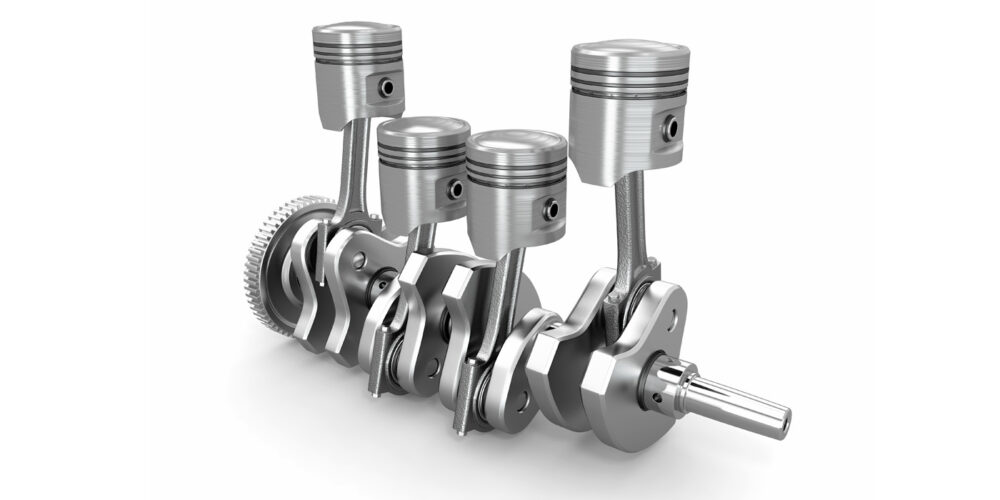Metallurgy is the study of the physical and chemical properties of metal, and when comparing different metals, the question becomes whether one wants to pursue a complicated degree in science, or whether you’re OK with accepting the basic facts around it.
The science is cool stuff, but I’ll leave it for my next life. I’m OK with the basic facts, and it’s the knowledge of these facts that makes it much easier to understand the basic types of crankshafts, or “cranks” for short.
In this industry, whether you’re interested in performance or not, you can’t escape the conversation of it, and one of the first things that always comes up is the term “forged” crank. Everyone knows the term and knows they’re better, but why?
Back up to the era of muscle cars and the exploding popularity of hot-rodding and aftermarket performance parts. As the horsepower wars accelerated throughout the ‘60s, the high-performance variants of any engine had one thing in common: a forged crank.
When you think about what a crank does, it harnesses all the power created by combustion and transfers that power to the transmission. Visualize what they go through: The power of combustion transfers through the piston and rod and into the rod journal to drive the crank into rotation. Meanwhile, the next cylinder in the firing order is compressing an air/fuel mixture in preparation for firing and driving the piston downward. Add to this engine speed and the momentum of pistons and rods that are holding on for dear life – not to mention the shock to the system by dumping a clutch to launch – and you can paint an easy picture of the immense forces pulling and twisting on the crank, just waiting to expose a weakness.
The bottom line is the crankshaft needs to handle the abuse it gets, and everything from compression to rpm to how hard the vehicle will be driven are factors that must be considered. This is why during the heyday of muscle cars the top performers had forged cranks. It was more than just handling the horsepower; it was the fact that these cars were going to be run hard over and over again, and many of them on the track.
Iron vs. Steel
Iron is a natural element that comes from the earth. Steel is a man-made alloy that’s a result of mixing iron with carbon, and it’s ultimately a stronger material. Those are some of the basic facts I was talking about. Metallurgy 101. Done.
Casting
For years, the traditional or “standard” crank was made of cast iron by pouring molten metal into a mold. When the casting is removed, it’s very close to the finished dimensions and comparatively requires minimal finishing. The entire process has a considerably lower cost than any other. As a result, this has been the standard crank of choice for automakers for many years.
Now, cast iron certainly is no wimpy material – think frying pan – and cast-iron cranks are very functional, but they have a limit to the amount of power they can handle in an engine. Generally, they’ll perform well up to the range of 450 to 500 horsepower, but when you reach that level (especially when driven hard on a regular basis), it’s time to move to something more durable, and the forged crank enters the picture.
Forging
A forged crank starts as a large cylinder of steel, heated to the molten state. It’s then pressed and/or twisted into shape by large dies. The ultimate difference between a casting and a forging is the resulting grain structure of the metal. A casting produces a sand-like grain versus the uniform flowing-grain structure of a forging. This grain structure is the reason for the difference between the strength of a cast and forged crank.
Billet
A billet crank starts as a large cylinder of steel, which then is machined into a crankshaft. Since a billet crank isn’t pressed or twisted in a forging process, the resulting grain structure runs parallel throughout the entire piece. Is a billet crank stronger than forged? Arguments go both ways, but billet seems to get the nod most of the time.
Just a Little More Metal
Cast cranks can be made of iron, nodular iron or steel. Add a small amount of carbon to iron and you have nodular iron. Steel has the greatest amount of carbon, and by definition is an alloy. There are thousands of different types of steels. Forged cranks, as well as billet, are made of multiple grades of these steel alloys. The difference in all – from least expensive to most – is tensile strength. Tensile strength is another term related to metallurgy. It refers to the amount of force that a metal will withstand before it begins to stretch.
So, the two underlying factors in crank strength are material and manufacturing process. Ultimately, you can go from bottom to top, aligning tensile strength, price and how much horsepower a crank will handle. Less costs less, more costs more. It’s that simple!













